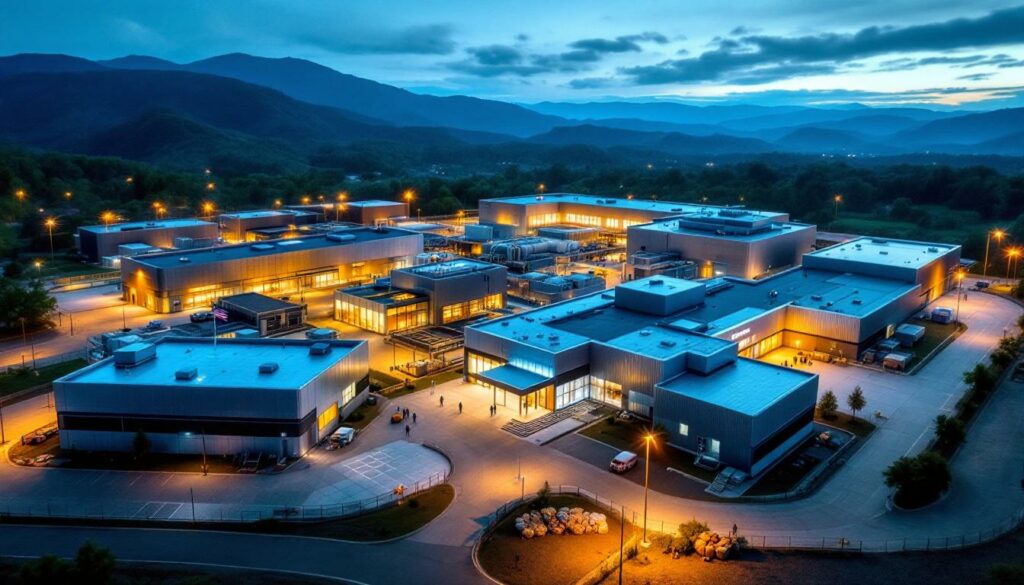Understanding the Y-12 Uranium Processing Facility Modernization Project
The Y-12 Uranium Processing Facility (UPF) represents one of the most significant investments in America's nuclear security infrastructure, designed to replace aging Manhattan Project-era facilities with modern technology. Located at the Y-12 National Security Complex in Oak Ridge, Tennessee, this comprehensive modernization effort ensures the continuation of critical uranium processing operations essential for national security.
As Audrey Beldio, NNSA Production Modernisation and Materials Management principal assistant deputy administrator, explains: "The modernisation of uranium operations at Y-12 is absolutely critical to the United States' nuclear weapons programme, the nuclear non-proliferation mission, and the Navy's nuclear fleet."
The Strategic Importance of Y-12 National Security Complex
The Y-12 facility has served as a cornerstone of America's nuclear security infrastructure since the 1940s. Today, it fulfills three essential missions that directly impact national security:
- Maintaining the nuclear weapons stockpile through specialized uranium processing operations
- Supporting global nuclear non-proliferation efforts by securing and accounting for nuclear materials
- Providing critical components for the naval nuclear propulsion program that powers America's submarine and aircraft carrier fleets
The original facilities, constructed during World War II as part of the Manhattan Project, have operated far beyond their intended lifespan. This aging infrastructure presented increasing safety risks, security vulnerabilities, and operational inefficiencies that necessitated a comprehensive modernization program.
How is the UPF Modernization Project Structured?
The Department of Energy's National Nuclear Security Administration (DOE/NNSA) implemented a strategic approach to manage this complex modernization effort. Rather than attempting a single massive construction project, they divided the UPF project into seven distinct subprojects, enabling better risk management, cost control, and schedule adherence.
The Seven Subprojects Approach
The modular implementation strategy includes these key components:
- Site Readiness – Completed
- Site Infrastructure and Services – Completed
- Substation – Completed
- Mechanical Electrical Building – Completed
- Process Support Facilities – Nearing completion (expected within 2025)
- Salvage and Accountability Building – Recently energized
- Main Process Building – Under construction
This phased approach has proven effective, with four subprojects already completed and the fifth expected to be finished within the year. The energization of the Salvage and Accountability Building represents a particularly significant milestone.
Key Milestone: Energization of the Salvage and Accountability Building
In June 2025, the project achieved a critical milestone with the energization of the Salvage and Accountability Building—the final structure to be connected to the Y-12 power grid. This achievement signals the transition into the final phase of construction.
"With the energisation of the final Uranium Processing Facility building, Y-12 is one step closer to modernising key processes," noted Rich Tighe, CNS president and CEO.
This milestone enables:
- Comprehensive testing of installed equipment and systems
- Validation of integrated facility operations
- Preparation for final commissioning activities
- Transition planning from legacy facilities
What Benefits Will the Modernized Facility Provide?
The UPF modernization delivers multiple benefits across safety, security, operational efficiency, and strategic capability domains.
Enhanced Safety and Security Protocols
The new facility implements significant improvements over the aging infrastructure:
- Modern safety systems engineered to current nuclear facility standards
- Enhanced security features aligned with contemporary threat assessments
- Improved environmental controls for contaminant management
- Reduced radiation exposure risks for personnel through advanced shielding
As Rich Tighe emphasized: "Safer and more efficient production operations is a long-term goal of the Y-12 team." This focus on safety represents a fundamental improvement over the original facilities designed during wartime conditions.
Operational Efficiency Improvements
Beyond safety considerations, the modernization effort delivers substantial operational benefits:
- Streamlined processing workflows through optimized facility layout
- Reduced operating costs with energy-efficient building systems
- Decreased maintenance expenses compared to aging infrastructure
- Improved working conditions for facility personnel
These efficiency gains ensure that Y-12 can fulfill its critical missions while minimizing resource requirements and operational costs over the coming decades.
Strategic National Security Benefits
The UPF project directly strengthens America's nuclear security capabilities by:
- Ensuring long-term viability of essential uranium processing operations
- Supporting nuclear deterrence through reliable weapons maintenance
- Enhancing nuclear material accountability for non-proliferation efforts
- Sustaining naval nuclear propulsion requirements for the fleet
These benefits represent crucial capabilities for America's defense posture and international security commitments.
Who is Involved in the UPF Project Implementation?
The UPF project involves a multi-layered management structure and diverse workforce that spans the nation.
Project Management Structure
The organizational framework includes:
- DOE/NNSA: Provides overall project oversight, funding, and strategic direction
- Consolidated Nuclear Security (CNS): Serves as the management and operating contractor
- Bechtel: Leads construction management under CNS direction
- Technical specialists: Provide expertise in nuclear facility design, safety systems, and specialized equipment
This management structure ensures appropriate oversight while maintaining specialized technical expertise throughout the project lifecycle.
Workforce and Economic Impact
The project represents a significant economic driver with nationwide impact:
- Approximately 2,500 workers directly supporting UPF construction activities
- Over 480 suppliers across 42 states contributing specialized components and services
- Diverse skill sets including nuclear engineering, construction trades, and quality assurance
- Knowledge transfer building workforce capabilities in advanced nuclear construction
This nationwide supply chain highlights the project's economic importance beyond the immediate Oak Ridge area, creating jobs and developing specialized skills across the country.
What Challenges Has the UPF Project Faced?
Like any major infrastructure project, the UPF modernization has encountered various challenges throughout its development.
Technical and Engineering Complexities
The project has navigated numerous technical hurdles:
- Integration with existing Y-12 infrastructure while maintaining operations
- Meeting stringent nuclear quality standards across all components and systems
- Managing radiological considerations throughout construction
- Implementing advanced safety features that exceed previous standards
Project Management Considerations
The scale and complexity of the UPF project presented management challenges:
- Schedule coordination across seven interdependent subprojects
- Budget management for specialized nuclear construction requirements
- Supply chain logistics for nuclear-qualified components
- Workforce development for specialized nuclear construction skills
The modular approach to implementation has helped address many of these challenges by breaking the overall project into manageable components with defined scopes and timelines.
What is the Current Status and Timeline?
The UPF project continues to progress toward full operational capability with several key milestones already achieved.
Completed Milestones
Significant accomplishments to date include:
- Four of seven subprojects completed: Site Readiness, Site Infrastructure and Services, Substation, and Mechanical Electrical Building
- Salvage and Accountability Building energized: The final structure connected to the Y-12 power grid
- Process Support Facilities nearing completion: Expected finalization within 2025
- Supply chain established: Over 480 suppliers across 42 states supporting production
As Audrey Beldio noted: "This milestone marks a significant step forward for Y-12, the 2,500 men and women supporting the UPF project, and the nation's nuclear security."
Remaining Work and Timeline
The project continues toward completion with:
- Process Support Facilities expected completion within 2025
- Main Process Building construction continuing
- Systems testing and commissioning entering advanced stages
- Transition planning from legacy facilities to new infrastructure
This phased approach ensures methodical progress while maintaining existing operations throughout the transition.
How Does the UPF Project Fit into Broader U.S. Energy and Security Strategy?
The UPF modernization represents an integral component of America's broader energy security initiatives and security strategy.
Nuclear Infrastructure Modernization
The project aligns with national initiatives to:
- Upgrade critical nuclear security infrastructure across the DOE complex
- Ensure domestic US uranium production technology remains viable
- Support nuclear deterrence posture through reliable facilities
- Maintain technical expertise in specialized nuclear operations
These efforts collectively strengthen America's nuclear security enterprise for decades to come.
Alignment with Uranium Security Initiatives
The UPF project complements other uranium-related developments, including the recently approved Anfield Energy's Velvet-Wood uranium-vanadium mine in Utah. This approval represents part of broader efforts to bolster the nation's mineral security and reduce dependence on foreign sources for critical materials.
Together, these initiatives create a more resilient nuclear infrastructure ecosystem that supports both energy and defense requirements while addressing US uranium market challenges.
What Makes the UPF Project Technically Innovative?
The UPF incorporates numerous technical innovations that represent significant advances over the original facilities.
Advanced Facility Design Features
Key innovations include:
- State-of-the-art material handling systems that minimize direct human contact
- Advanced containment and ventilation technologies to prevent contamination
- Modern instrumentation and control systems for precise process management
- Energy-efficient building systems that reduce operational footprints
These technical advances ensure that the facility remains viable and efficient throughout its operational lifetime.
Nuclear Safety Enhancements
Safety innovations are particularly significant:
- Enhanced seismic design exceeding previous standards
- Improved fire protection systems throughout the facility
- Advanced radiation shielding for worker protection
- Redundant safety systems to prevent operational incidents
These features collectively create a dramatically safer work environment while enhancing the security of nuclear materials through advanced nuclear waste safety technology.
FAQs About the Y-12 Uranium Processing Facility
What is the primary purpose of the Y-12 Uranium Processing Facility?
The UPF serves as the central hub for enriched uranium operations supporting the U.S. nuclear weapons stockpile, nuclear non-proliferation efforts, and naval nuclear propulsion programs, replacing World War II-era facilities with modern infrastructure.
How significant is this project in terms of national security?
As stated by NNSA's Audrey Beldio, the modernization is "absolutely critical to the United States' nuclear weapons programme, the nuclear non-proliferation mission, and the Navy's nuclear fleet," underscoring its fundamental importance to national security.
What makes the energization of the Salvage and Accountability Building significant?
As the final building to be connected to the Y-12 power grid, this milestone marks the transition into the project's final construction phase, enabling comprehensive testing of installed equipment and systems integration.
How has the project benefited the U.S. economy?
Beyond enhancing national security, the UPF project has created approximately 2,500 jobs directly related to construction and engaged over 480 suppliers across 42 states, generating significant economic activity nationwide.
How does this project compare to other nuclear infrastructure investments?
The UPF represents one of the largest investments in U.S. nuclear security infrastructure in recent decades, reflecting the critical importance of maintaining uranium processing capabilities for national security purposes. Furthermore, its design incorporates lessons from the uranium market dynamics of recent years.
What environmental improvements will the new facility provide?
The modernized facility incorporates contemporary environmental controls and safety systems that significantly reduce risks compared to the aging infrastructure it replaces, improving both worker safety and environmental protection according to the Y-12 National Security Complex.
Note: The Y-12 UPF modernisation project demonstrates America's commitment to maintaining critical nuclear security capabilities while addressing the safety, security, and operational challenges of aging infrastructure. As this project progresses toward completion, it will ensure the continued viability of essential uranium processing operations for decades to come.
Ready to Spot the Next Major Mining Discovery?
Discover why significant mineral discoveries can lead to exceptional returns by exploring Discovery Alert's dedicated discoveries page, where proprietary Discovery IQ technology transforms complex ASX announcements into actionable investment opportunities before the broader market catches on.




